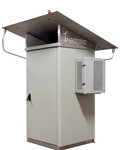text to clipboard
Intertec at EES (Electrical Energy Storage) Europe, Munich, June 20-22, booth C1.232
Outdoor protection expert launches passively cooled enclosures for field-based energy storage systems
• optimizes protection and reliability for energy storage applications in harsh environments
Munich, Germany, June 20, 2018 --- At EES, Intertec is launching a range of ultra-robust enclosures for protecting field-based energy storage and electronics equipment. To minimize the long-term cost of ownership of field-based equipment in this fast-growing market, the enclosures employ advanced composite-GRP (glass fiber reinforced polyester) structural materials. Moreover, they can be fitted with a complete choice of coolers to optimize battery performance and reliability - including fully-passive systems which operate without electric power.
The global move towards renewable energy is opening up hundreds of new applications for distributed energy storage systems and electronics control equipment. As many applications in the sector are located outdoors and remotely, and will demand long lifecycles and low cost of ownership, Intertec believes enclosures fabricated from advanced GRP materials will become a mainstream protection solution.
Intertec expects GRP to succeed because of the immense track record this material has in the processing industries. GRP enclosures have become the preferred solution for process control and instrumentation protection in the most demanding outdoor applications in the world today. These applications include extreme environments such as the Arctic Circle, deserts, and coastal and offshore locations. Intertec has more than 50 years' experience of developing GRP enclosures for such applications and has a large portfolio of advanced composite-GRP materials to cope with the environmental protection challenges they present.
In addition to these attributes, Intertec will design and fit enclosures with custom internal environmental controls - such as the temperature regulation that is often required to optimize the life of battery systems. Options include unique passive and hybrid cooling systems - which eliminate or reduce the need for electric power and provide project design engineers with exceptionally reliable solutions.
Two main passive cooling technology options are available. Pure passive cooling systems for field enclosures from Intertec include a water circulation system with internal and external heat exchangers. The technology works by exploiting the temperature swing over the daily cycle. The water is cooled during the night when temperatures are lower. The cool water then reduces the enclosure's internal temperature during the day. Natural convection moves the water around the system. This solution is widely used today in arid and desert application environments, and Intertec has built many hundreds of this type of field shelter.
When configuring passive cooling systems a critical parameter is night temperature. This provides the driving force for the natural circulation that transports heat out of the enclosure. The lower the night temperature, the more efficient passive cooling becomes. By adding one or more active, powered cooling elements, Intertec can create hybrid cooled enclosures and shelters that can be used in many different climates - from arid to temperate or even equatorial regions. Hybrid passive cooling can be easily achieved by adding a water chiller such as Intertec's Hybricool unit. This direct water chiller reduces the temperature of the water tank whenever electricity is available - from the grid or solar power. If the electricity supply should fail for any reason - or the water chiller should fail - the passive element of the cooling system will continue to operate and keep the energy storage system and electronics equipment cool, providing plenty of time for maintenance staff to visit the site and make repairs.
In addition to passive and hybrid passive cooling, Intertec can fit enclosures with conventional powered cooling systems such as air conditioners - including specialized versions for operation in hazardous areas.
Intertec offers a spectrum of outdoor enclosure shapes and sizes, from boxes and enclosures for smaller-scale applications, through to larger equipment cabinets and walk-in shelters. In addition to standard shapes and sizes, Intertec offers probably the largest choice of composite-GRP construction materials to optimize the enclosures for particular applications. The protection challenges that can be handled include insulation for reliable operation in extreme climates, explosion proofing, fire resistance, and near perfect protection against corrosion, ultraviolet radiation, and many other challenges.
"The renewable energy industry is still at a relatively early stage and we have seen a number of companies protecting outdoor equipment using ad-hoc outdoor protection solutions such as adapted containers", says Intertec's CEO Martin Hess. "GRP materials, and particularly specialized composite-GRP variations, have an unparalleled record in providing long lifecycle protection and offer designed-for-purpose protection solutions for housing control electronics and energy storage systems."
ENDS
For further information please contact:
Intertec Instrumentation Ltd, 255 Henry Drive, Sarnia, Ontario N7T 7H5, Canada. Tel: +1 888 875 8756; info@intertec-inst.com
Intertec Instrumentation, Inc., 11050 West Little York, Houston, TX 77041, USA. t: +1 832 554-1150; info@intertec-inst.com
Background information on Intertec
Intertec produces protective enclosures for field-based process instrumentation and control equipment, using glass fiber reinforced polyester (GRP). This material offers remarkable advantages for oil and gas applications (including natural corrosion resistance, low weight, extended durability for long life applications, much higher thermal resistance than metal – making it easier to insulate against heat and cold – and benign environments for wireless communications). A broad range of enclosures, cabinets and shelters, plus a comprehensive selection of accessories including heating and cooling components, protect against freezing, condensation, solar radiation/UV, explosion, fire, corrosion, impact, etc. Intertec has designed and shipped over a million instrument protection enclosures since 1965, to protect equipment operating in the most demanding operating conditions on Earth - from Arctic regions to deserts to harsh coastal and offshore environments. Application-specific protection may be configured using free software tools. Or, Intertec will configure a turnkey solution for clients, using know-how that has evolved over more than 50 years. Intertec manufactures in Neustadt (Germany), Sarnia (Canada), and Houston (USA), and also has an assembly and system building center in Russia. www.intertec.info









 |
|